The best composting toilets for tiny houses
Waste disposal seems to be a very hot topic in the tiny house world, and I just want to weigh in on what I believe to be the best toilet options. Some people may prefer a traditional flush toilet if they can park where they will have a sewage or septic connection (usually an RV park). But flush toilets use a lot of water and most tiny housers won't find parking where sewage disposal is easy or possible. For that reason, the #1 solution for a tiny houses toilet (by far!) is a composting toilet.
Incinerating toilets and toilets that shrink-wrap or otherwise bag the waste as also options. However, these have serious downsides. Incinerating toilets tend to have smell issues (doesn't make for happy neighbors) and they require a lot of electricity with fans and other moving parts that can break. Shrink-wrap toilets may allow you to throw your waste in the trash, but that's just adding dangerous waste to our landfills and even more plastic to wrap it up. Doesn't seem like a very sustainable solution to me!
My preference (and the simplest & cheapest option) is a simple bucket system. More on that later. For now, here's a rundown of the best manufactured composting toilets available for tiny houses.
Separett
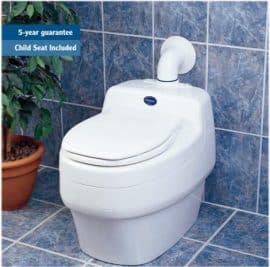
One of the most in-depth reviews of the Separett Villa is by Gabriella Morrison of Tiny House Build. She says:
We recently purchased the Separett composting toilet and we couldn’t be happier with it. It is SO easy to use, to clean and it has absolutely no odor to it whatsoever. This is hands down the best system out there as far as we’re concerned. The only downside we see is the cost (though we honestly believe it was worth every penny). Read more...
The Separett Villa (made in Sweden) is well known as the first composting toilet with a unique design that separates urine from solid waste, which leads to a nearly odor free process.
The Separett does, however, require the running of an internal fan (ideally 24/7) to dry out the waste and keep it odor-free. The fan requires 17 watts for the Separett 9200 AC (which plugs in to a regular wall outlet). Because of the fan, the unit most also be vented to the outside of the house.
The Separett also allow you to line the solid waste compartment with a compostable plastic bag, making it easy to take the waste out to a compost bin, or if needed, to the garbage.
Nature's Head
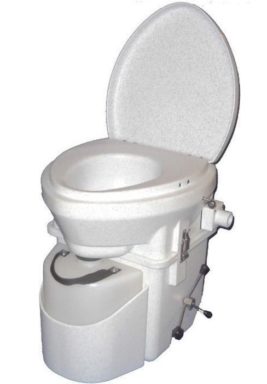
The Nature's Head composting toilet sells for less than the Separett, and can be found for under $1,000. It's still a considerable investment for a fancy piece of plastic, but by all accounts, this is also a very good option.
Jenna Spesard of Tiny House Giant Journey has a great review of the Nature's Head. She concludes:
After one year of using the Nature’s Head composting toilet, we have no complaints. In fact, is it weird to say we’ve actually become good at using it? We’ve perfected our ratio: amount of peat moss versus the amount of stirring, so that the solids chamber is in top notch condition. It took a few months to get used to the system, but now, we’re professionals. Read more...
The Nature's head also has a small internal fan and needs to be vented through the wall to the outdoors.
The Nature's Head toilet is NOT designed for use with any kind of bag or liner, so that the waste can begin to compost properly and so the bag does not get twisted up in the agitator.
Note: Brands like SuMar and Biolet also produce dry composting toilets, but have more mixed reviews. I have included only the Separett and Nature's Head as I believe those to be the two best choices (with proven results).
Other Options (a bucket!)
What if you don't want to spend $1,000 or more on a toilet? Is there still a way to compost your waste (and forgo the sewage or septic system)? Yes, there certainly is!

In my tiny house I use a simple bucket system (with outdoor compost pile) as described in this book.
It's been more than 3 years now, and I have found it to be a very cost-effective, odor-free, safe and simple process. It takes just 5 minutes, maybe twice a week to empty the bucket into the compost pile, clean the bucket, cover the pile with straw, and replenish the sawdust (cover material) as needed.
A thorough reading of the Humanure Handbook is a must to understand how to properly compost human waste, but essentially all it takes on a regular basis is some suitable cover material (like sawdust or peat moss).
Unlike the expensive manufactured toilets above, the bucket system does not require the running of an electric fan (though a bathroom exhaust fan is always a good idea). The cost to build this system is nearly free.
You can choose to build a urine diverter if you wish, then dilute your urine with water and use it as an excellent fertilizer. Urine is sterile in most all cases and when diluted is perfectly safe to use on anything that needs a boost of nitrogen.
If you do not separate out the liquids, you will likely need to use more cover material and will need to take out your bucket a bit more to keep your bathroom odor free. I encourage you to experiment to find out what works best for you and your family.
Dealing with human waste can be a squeamish subject for many, but if you are serious about tiny living and interested in simpler living at a lower cost, I strongly suggest you consider a composting bucket system.
Cover Material
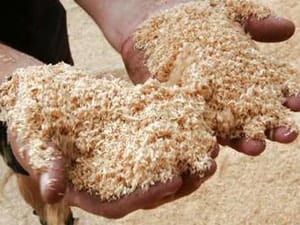
If you don't live near a saw mill, see if you can pick up bags of waste sawdust (from non-treated lumber only) from your local cabinet maker, furniture maker or carpentry shop.
Alternatively, you can always go to the store and buy a large bag of peat moss, which works well but smells a bit more earthy.
You can also use the hulls or waste materials from coconut, rice, coffee or nearly any grain, bean or seed that has a soft hull or husk waste product. I tried coffee hulls once and my bathroom smelled like a sweet cup of coffee all day long!


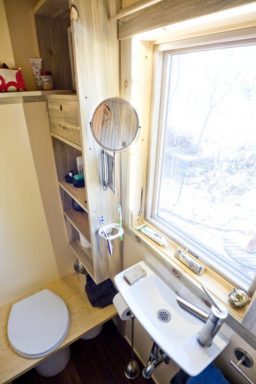
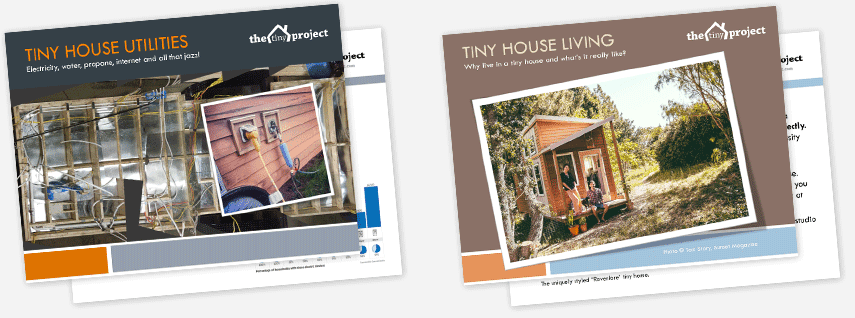
I personally believe composting toilets are wonderful. They truly allow you to live anywhere. Having a real toilet was such a huge concern when I considered going tiny.